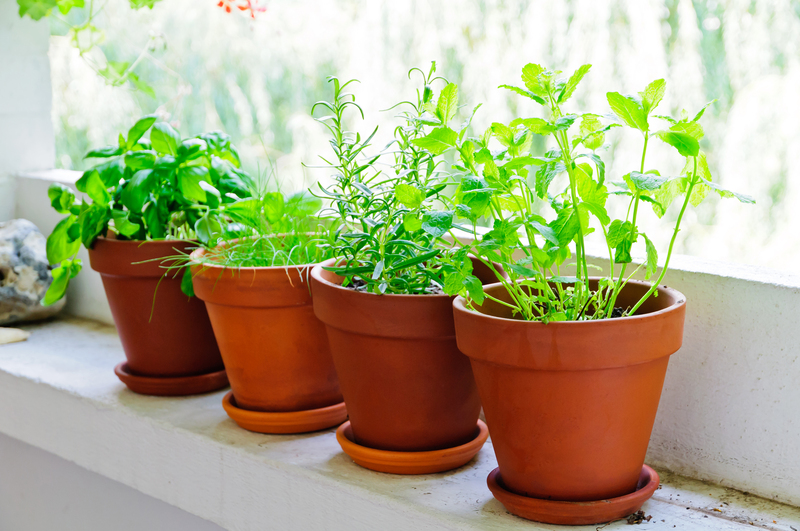Architectural Foliage: Trendsetting Hedge Trimming Shapes and Techniques
Posted on 28/09/2025
Architectural Foliage: Trendsetting Hedge Trimming Shapes and Techniques
In the evolving world of landscaping, architectural foliage is setting new benchmarks for gardens and outdoor spaces. Hedge trimming shapes and techniques have transitioned from functional barriers to eye-catching elements that define space, artistry, and style. Whether you have a classic English garden or a contemporary urban retreat, understanding the latest hedge design trends can transform your green boundaries into living sculptures.

The Evolution of Hedge Trimming and Architectural Foliage
For centuries, hedges have offered privacy, security, and structure to gardens. Traditionally, hedges were trimmed into simple geometric forms for practicality and ease. However, the modern gardener's approach to hedge shaping techniques now includes innovative aesthetics. Architectural foliage is about showcasing skill and vision, creating landscape features that captivate the imagination while maintaining ecological value.
Before exploring today's trendsetting hedge trimming shapes and techniques, understanding their cultural and historical context can provide meaningful inspiration.
- Ancient Topiary: Originating in Roman gardens, topiary art showcased the power and elegance of carefully curated greenery.
- Formality in English Gardens: The stiff, tidy hedges of earlier centuries reflected order and control over nature.
- Modern Movement: The late 20th and 21st centuries shifted toward expressive forms and ecological balance.
Why Modern Gardens Embrace Trendsetting Hedge Designs
Why do homeowners and landscape professionals increasingly turn to innovative hedge trimming patterns? The answer lies within the dynamic interplay between beauty, function, and sustainability:
- Artistry & Expression -- Architectural hedges make bold statements, turning gardens into outdoor galleries.
- Customization -- Unique shapes reflect personality, taste, or even branding for commercial spaces.
- Biodiversity -- Purposeful trimming can support wildlife with shelter and foraging spaces.
- Space Optimization -- Innovative shaping maximizes privacy while preserving light, air, and views.
With these benefits, it's no surprise that trendsetting hedge sculpting is at the forefront of landscape design.
Hottest Hedge Trimming Shapes in 2024
If you want your landscape to stand out, incorporate these popular architectural foliage shapes into your design.
Geometric Minimalism
Polished lines, acute angles, and simple forms are the cornerstones of geometric hedge trimming. These modern, minimalistic designs work well in both large and small gardens, offering a clean, sophisticated appeal. Common shapes include:
- Rectangles (for classic, low-maintenance borders)
- Cubes (perfect for framing entrances or pathways)
- Spirals (visual interest with a contemporary twist)
- Pyramids and Obelisks (height and drama without overcrowding)
Organic & Flowing Forms
For those seeking a softer, more naturalistic look, modern architectural hedge shaping also embraces fluid curves and wave patterns. These forms mimic nature, offering movement and a sense of tranquility.
- Undulating Waves: Hedges sculpted into rolling curves evoke the serenity of water or wind-blown grass.
- Multilevel Tiering: Staggering heights mimic natural slopes and provide visual depth.
- Dome & Mound: Gentle hills blend seamlessly into organic landscapes.
Artistic Topiary
Bold gardeners are reviving topiary artistry with inventive, bespoke forms. Current trends blend classical inspiration with contemporary flourishes:
- Animal Motifs: Birds, rabbits, and even mythical creatures bring whimsy and personality to the landscape.
- Abstract Forms: Freeform, asymmetrical shapes make a statement in modern courtyards.
- Custom Logos & Shapes: Ideal for businesses and public spaces that want to showcase a brand or unique identity through living greenery.
Vertical Walls and Living Screens
Urban and small-space gardens are driving the rise of vertical hedge designs. Tall, narrow hedges double as privacy screens and design elements, creating lush, green architecture that makes efficient use of limited area:
- Green Walls: Hedges trimmed into flat, upright planes for privacy while maximizing floor space.
- Tiered Screens: Multi-layered hedges with staggered heights for added depth and texture.
Feature Hedges & Green Sculptures
Make hedges the focal point, not just the boundary! Feature hedges are strategically placed and intricately trimmed to draw attention, guide movement, or create outdoor rooms:
- Maze and Labyrinth: Interactive, playful, and rooted in classical garden design.
- Archways & Tunnels: Invite movement and create enchanting passageways through living foliage.
- Columns & Posts: Emphasize verticality at gates, driveways, or patios.
Popular Plants for Architectural Hedges
Not all plants are created equal when it comes to trendsetting hedge trimming. The best choices combine dense growth, tolerance of regular cutting, and resilience to diseases. Here are top plant varieties for architectural foliage:
- Boxwood (Buxus sempervirens): The classic topiary plant, perfect for intricate shapes and crisp lines.
- Yew (Taxus baccata): Popular for longevity, versatility, and deep green color; yews thrive in most climates.
- Privet (Ligustrum): Fast-growing and easy to maintain, ideal for geometric or organic forms.
- Photinia: Adds seasonal interest with red-tinted new growth, great for modern curves and flowing shapes.
- Holly (Ilex species): Prickly, evergreen, and full, perfect for secure property boundaries.
- Laurus nobilis (Bay laurel): Excellent for structural, upright trimming and aromatic as a bonus!
Essential Tools & Equipment for Modern Hedge Sculpting
Quality tools are a must for achieving advanced hedge shaping results. Serious artists and weekend gardeners alike benefit from the right equipment:
- Electric or Battery-operated Hedge Trimmers: Efficient for large surfaces and consistent lines.
- Hand Shears: Precision for detailed work on topiaries and intricate designs.
- Topiary Frames: Wire or plastic forms helpful for complex or repetitive shapes.
- Loppers and Pruning Saws: For major cuts and dense hardwood branches.
- String and Stakes: Mark boundaries for geometric patterns and keep alignments accurate.
- Level and Measuring Tape: Essential for symmetry and balance in design.
Expert Techniques: Achieving Perfect Hedge Shapes
It's not just about the tool; proper technique elevates your architectural hedge designs from ordinary to extraordinary.
Hedge Shaping Best Practices
- Start with Healthy, Well-Spaced Plants: Allow space for future growth and airflow.
- Trim Gradually: Small, regular prunings encourage dense, bushy growth.
- Work from the Bottom Up: Keep base slightly wider than the top for sunlight access and stability.
- Mark Your Lines: Use string, chalk, or guides to keep cuts straight and even.
- Step Back Often: Inspect as you go to catch irregularities early.
Advanced Topiary Techniques
- Wire Frame Guides: Shape young plants around a frame for consistency; ideal for animals or logos.
- Selective Pruning: Remove interior branches to reveal desired form or highlight unique features.
- Seasonal Timing: Most formal trimming is done after the main growth period; light shaping can be year-round.
- Embrace Asymmetry: Modern design often favors dynamic, asymmetrical forms for visual appeal.
Top Tips for Maintaining Trendsetting Hedge Shapes
A living boundary requires ongoing care. Here's how to keep your architectural foliage looking its best all year round:
- Feed and Mulch: Healthy growth starts with good soil. Apply slow-release fertilizer and an organic mulch each spring.
- Water Wisely: Young hedges need regular watering; established plants often survive on rainfall except during droughts.
- Pest and Disease Management: Inspect regularly for signs of blight, scale, or insect damage. Early intervention is key.
- Annual Reshaping: Even low-maintenance designs need yearly shaping to maintain crisp lines.
- Rejuvenation Pruning: Every 5-10 years, perform deeper trims to keep plants dense and healthy at the base.
Eco-conscious Approaches to Sculpted Hedges
As climate awareness grows, so does the desire for eco-friendly hedge trimming. Sustainability can be stylish:
- Native Species: Choose local plants that require less water and pesticides.
- Wildlife Corridors: Design open areas or mixed species for birds, pollinators, and beneficial insects.
- Compost Clippings: Recycle hedge trimmings as mulch or compost to return nutrients to the soil.
- Minimal Chemical Use: Embrace natural pest management and hand-weeding wherever possible.
Inspiration from World-famous Architectural Hedges
Need creative inspiration? Explore these internationally recognized examples of architectural hedge trimming:
- Levens Hall, UK: Home to the world's oldest topiary garden, featuring dramatic spirals and geometric shapes.
- Chateau de Villandry, France: Intricate boxwood parterres and lush green tapestries define this Renaissance masterpiece.
- Longwood Gardens, USA: Modern interpretations incorporate sweeping curves and elaborate living sculptures.
Visit botanical gardens, stately homes, or landscape festivals to see the latest hedge architecture trends in action.

DIY vs. Professional Hedge Sculpting
While some enthusiasts love the challenge of trimming their own architectural foliage, intricate designs often benefit from professional expertise.
- DIY Gardeners: Start with simple geometric shapes and gradually progress to more advanced patterns as skills improve.
- Landscaping Professionals: Consider investing in bespoke designs and regular maintenance for a high-end look.
Whether DIY or pro, patience and planning are essential for success in trendsetting hedge artistry.
Conclusion: Elevate Your Garden with Architectural Foliage
The era of monotonous, utilitarian horticulture is over. Architectural foliage and modern hedge trimming shapes inspire creativity, sustainability, and personalized landscapes.
By embracing the latest hedge design trends, tools, and techniques, you can transform your property into a unique sanctuary. From crisp geometric lines to playful animal forms and undulating waves, the possibilities are endless. Start with simple shapes, experiment with plant choices, and ensure ongoing care for a stunning green spectacle that reflects your own artistic vision.
For more in-depth guides and hedge trimming inspiration, stay tuned for our latest tips on creative garden architecture and living sculptures!

